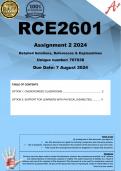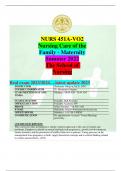RCE2601
Assignment 2 2024
Detailed Solutions, References & Explanations
Unique number: 767038
Due Date: 7 August 2024
TABLE OF CONTENTS
OPTION 1: OVERCROWDED CLASSROOMS ......................................................... 2
OPTION 2: SUPPORT FOR LEARNERS WITH PHYSICAL DISABILITIES ............ 11
Terms of use
By making use of this document you agree to:
• Use this document as a guide for learning, comparison and reference purpose,
• Not to duplicate, reproduce and/or misrepresent the contents of this document as your own work,
• Fully accept the consequences should you plagiarise or misuse this document.
Disclaimer
Extreme care has been used to create this document, however the contents are provided “as is” without
any representations or warranties, express or implied. The author assumes no liability as a result of
reliance and use of the contents of this document. This document is to be used for comparison, research
and reference purposes ONLY. No part of this document may be reproduced, resold or transmitted in any
form or by any means.
, +27 67 171 1739
OPTION 1: OVERCROWDED CLASSROOMS
OVERCROWDED CLASSROOMS IN SOUTH AFRICA: IMPACT ON LEARNING
AND POTENTIAL SOLUTIONS
INTRODUCTION
Overcrowded classrooms have increasingly become a global educational challenge.
According to a UNESCO report (2015), an ideal student-to-teacher ratio is critical for
creating conducive learning environments. Unfortunately, burgeoning class sizes have
escalated the workload for educators and diluted instructional quality, thus impeding
student learning outcomes (OECD, 2018). In South Africa, this problem is particularly
acute, affecting not only academic performance but also the holistic development of
students.
Environmental factors significantly influence a child’s cognitive and emotional growth,
making the issue of overcrowded classrooms worthy of urgent attention. Studies have
shown that overcrowded classrooms contribute to heightened anxiety, decreased
individual attention, and reduced participation, all of which undermine effective
teaching and learning (Spaull, 2013). Furthermore, the South African Constitutional
Court mandates the right to basic education for all children, suggesting that systemic
barriers like overcrowded classrooms need to be addressed to fulfill this constitutional
promise (Beiter, 2005). This paper explores the impact of overcrowded classrooms on
student learning and explores viable measures to mitigate this growing concern. By
addressing this issue, it is not merely the academic performance that stands to benefit
but also the broader development landscape of South Africa’s future generations.
PROBLEM STATEMENT
The issue of overcrowded classrooms in South Africa garnered my attention due to its
significant repercussions on both educational quality and student well-being. The
sheer scale of the problem is alarming, as illustrated by reports indicating that student-
to-teacher ratios frequently exceed recommended limits, thereby exacerbating
challenges in effective teaching (UNESCO, 2015). Overcrowded classrooms lead to
Disclaimer
Extreme care has been used to create this document, however the contents are provided “as is” without
any representations or warranties, express or implied. The author assumes no liability as a result of
reliance and use of the contents of this document. This document is to be used for comparison, research
and reference purposes ONLY. No part of this document may be reproduced, resold or transmitted in any
form or by any means.





